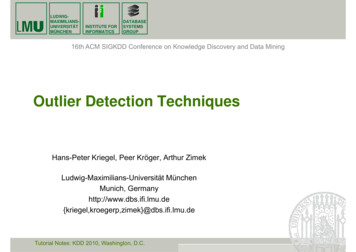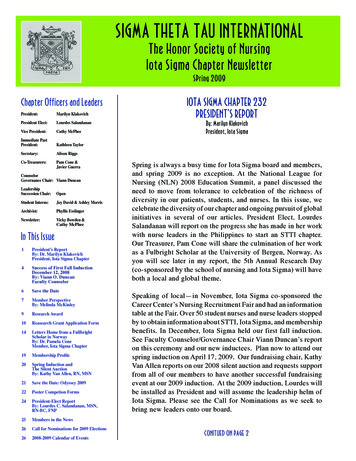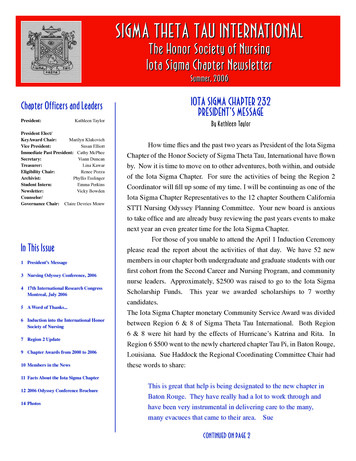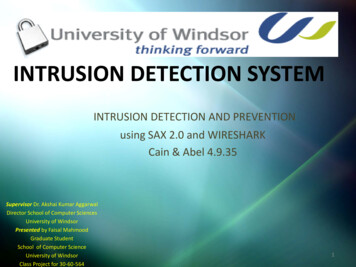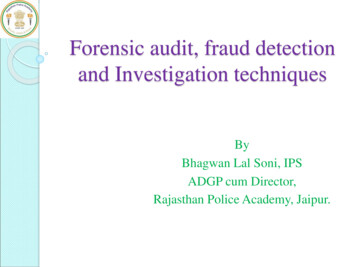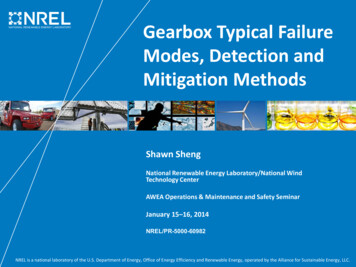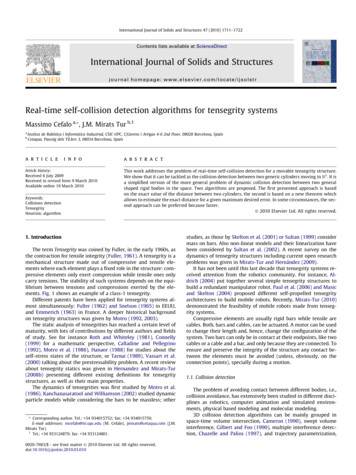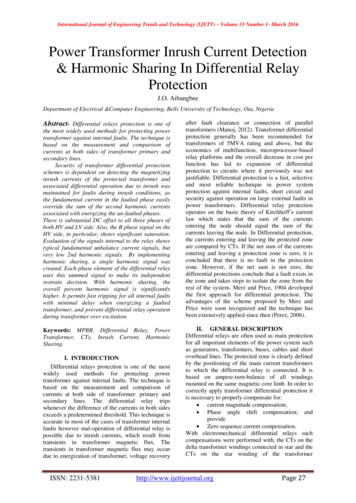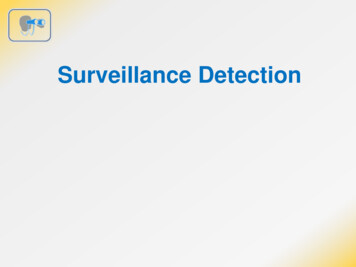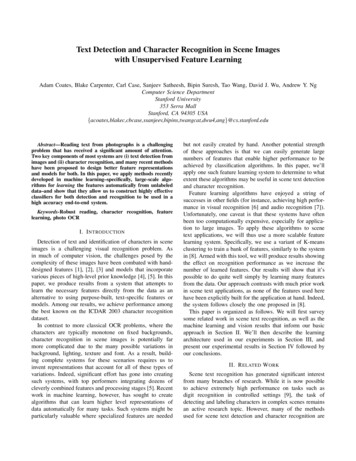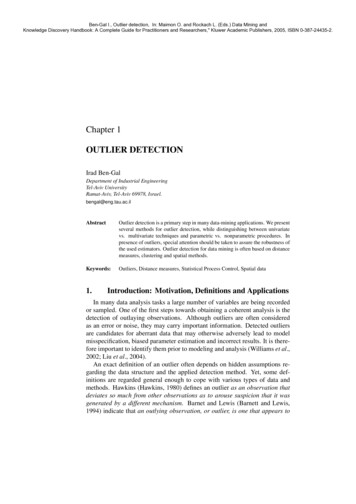
Transcription
Ben-Gal I., Outlier detection, In: Maimon O. and Rockach L. (Eds.) Data Mining andKnowledge Discovery Handbook: A Complete Guide for Practitioners and Researchers," Kluwer Academic Publishers, 2005, ISBN 0-387-24435-2.Chapter 1OUTLIER DETECTIONIrad Ben-GalDepartment of Industrial EngineeringTel-Aviv UniversityRamat-Aviv, Tel-Aviv 69978, Israel.bengal@eng.tau.ac.ilAbstractOutlier detection is a primary step in many data-mining applications. We presentseveral methods for outlier detection, while distinguishing between univariatevs. multivariate techniques and parametric vs. nonparametric procedures. Inpresence of outliers, special attention should be taken to assure the robustness ofthe used estimators. Outlier detection for data mining is often based on distancemeasures, clustering and spatial methods.Keywords:Outliers, Distance measures, Statistical Process Control, Spatial data1.Introduction: Motivation, Definitions and ApplicationsIn many data analysis tasks a large number of variables are being recordedor sampled. One of the first steps towards obtaining a coherent analysis is thedetection of outlaying observations. Although outliers are often consideredas an error or noise, they may carry important information. Detected outliersare candidates for aberrant data that may otherwise adversely lead to modelmisspecification, biased parameter estimation and incorrect results. It is therefore important to identify them prior to modeling and analysis (Williams et al.,2002; Liu et al., 2004).An exact definition of an outlier often depends on hidden assumptions regarding the data structure and the applied detection method. Yet, some definitions are regarded general enough to cope with various types of data andmethods. Hawkins (Hawkins, 1980) defines an outlier as an observation thatdeviates so much from other observations as to arouse suspicion that it wasgenerated by a different mechanism. Barnet and Lewis (Barnett and Lewis,1994) indicate that an outlying observation, or outlier, is one that appears to
Ben-Gal I., Outlier detection, In: Maimon O. and Rockach L. (Eds.) Data Mining andKnowledge Discovery Handbook: A Complete Guide for Practitioners and Researchers," Kluwer Academic Publishers, 2005, ISBN 0-387-24435-2.2deviate markedly from other members of the sample in which it occurs, similarly, Johnson (Johnson, 1992) defines an outlier as an observation in a dataset which appears to be inconsistent with the remainder of that set of data.Other case-specific definitions are given below.Outlier detection methods have been suggested for numerous applications,such as credit card fraud detection, clinical trials, voting irregularity analysis,data cleansing, network intrusion, severe weather prediction, geographic information systems, athlete performance analysis, and other data-mining tasks(Hawkins, 1980; Barnett and Lewis, 1994; Ruts and Rousseeuw, 1996; Fawcettand Provost, 1997; Johnson et al., 1998; Penny and Jolliffe, 2001; Acuna andRodriguez, 2004; Lu et al., 2003).2.Taxonomy of Outlier Detection MethodsOutlier detection methods can be divided between univariate methods, proposed in earlier works in this field, and multivariate methods that usually formmost of the current body of research. Another fundamental taxonomy of outlier detection methods is between parametric (statistical) methods and nonparametric methods that are model-free (e.g., see (Williams et al., 2002)). Statistical parametric methods either assume a known underlying distribution ofthe observations (e.g., (Hawkins, 1980; Rousseeuw and Leory, 1987; Barnettand Lewis, 1994)) or, at least, they are based on statistical estimates of unknown distribution parameters (Hadi, 1992; Caussinus and Roiz, 1990). Thesemethods flag as outliers those observations that deviate from the model assumptions. They are often unsuitable for high-dimensional data sets and forarbitrary data sets without prior knowledge of the underlying data distribution(Papadimitriou et al., 2002).Within the class of non-parametric outlier detection methods one can setapart the data-mining methods, also called distance-based methods. Thesemethods are usually based on local distance measures and are capable of handling large databases (Knorr and Ng, 1997; Knorr and Ng, 1998; Fawcettand Provost, 1997; Williams and Huang, 1997; Mouchel and Schonlau, 1998;Knorr et al., 2000; Knorr et al., 2001; Jin et al., 2001; Breunig et al., 2000;Williams et al., 2002; Hawkins et al., 2002; Bay and Schwabacher, 2003). Another class of outlier detection methods is founded on clustering techniques,where a cluster of small sizes can be considered as clustered outliers (Kaufmanand Rousseeuw, 1990; Ng and Han, 1994; Ramaswamy et al., 2000; Barbaraand Chen, 2000; Shekhar and Chawla, 2002; Shekhar and Lu, 2001; Shekharand Lu, 2002; Acuna and Rodriguez, 2004). Hu and Sung (Hu and Sung,2003), whom proposed a method to identify both high and low density patternclustering, further partition this class to hard classifiers and soft classifiers.The former partition the data into two non-overlapping sets: outliers and non-
Ben-Gal I., Outlier detection, In: Maimon O. and Rockach L. (Eds.) Data Mining andKnowledge Discovery Handbook: A Complete Guide for Practitioners and Researchers," Kluwer Academic Publishers, 2005, ISBN 0-387-24435-2.3Outlier Detectionoutliers. The latter offers a ranking by assigning each datum an outlier classification factor reflecting its degree of outlyingness. Another related class ofmethods consists of detection techniques for spatial outliers. These methodssearch for extreme observations or local instabilities with respect to neighboring values, although these observations may not be significantly different fromthe entire population (Schiffman et al., 1981; Ng and Han, 1994; Shekhar andChawla, 2002; Shekhar and Lu, 2001; Shekhar and Lu, 2002; Lu et al., 2003).Some of the above-mentioned classes are further discussed bellow. Othercategorizations of outlier detection methods can be found in (Barnett and Lewis,1994; Papadimitriou et al., 2002; Acuna and Rodriguez, 2004; Hu and Sung,2003).3.Univariate Statistical MethodsMost of the earliest univariate methods for outlier detection rely on the assumption of an underlying known distribution of the data, which is assumedto be identically and independently distributed (i.i.d.). Moreover, many discordance tests for detecting univariate outliers further assume that the distribution parameters and the type of expected outliers are also known (Barnett andLewis, 1994). Needless to say, in real world data-mining applications theseassumptions are often violated.A central assumption in statistical-based methods for outlier detection, is agenerating model that allows a small number of observations to be randomlysampled from distributions G1 ,. . . , Gk , differing from¡ the targetdistribution F , which is often taken to be a normal distribution N µ, σ 2 (see (Ferguson,1961; David, 1979; Barnett and Lewis, 1994; Gather, 1989; Davies and Gather,1993)). The outlier identification problem is then translated to the problem ofidentifying those observations that lie in a so-called outlier region. This leadsto the following definition (Davies and Gather, 1993):¡For any confidence coefficient α, 0 α 1, the α-outlier region of theN µ, σ 2 distribution is defined by¡ ªout α, µ, σ 2 x : x µ z1 α/2 σ ,(1.1)where zq is the q ¡quintile of the N (0,1). A number x is an α-outlier with respectto F if x out α,µ,σ 2 . Although traditionally the normal distribution hasbeen used as the target distribution, this definition can be easily extended toany unimodal symmetric distribution with positive density function, includingthe multivariate case.Note that the outlier definition does not identify which of the observationsare contaminated, i.e., resulting from distributions G1 ,. . . , Gk , but rather itindicates those observations that lie in the outlier region.
Ben-Gal I., Outlier detection, In: Maimon O. and Rockach L. (Eds.) Data Mining andKnowledge Discovery Handbook: A Complete Guide for Practitioners and Researchers," Kluwer Academic Publishers, 2005, ISBN 0-387-24435-2.43.1Single-step vs. Sequential ProceduresDavis and Gather (Davies and Gather, 1993) make an important distinctionbetween single-step and sequential procedures for outlier detection. Singlestep procedures identify all outliers at once as opposed to successive elimination or addition of datum. In the sequential procedures, at each step, oneobservation is tested for being an outlier.With respect to Equation 1.1, a common rule for finding the outlier regionin a single-step identifier is given by¡ out αn , µ̂n , σ̂n2 {x : x µ̂n g (n, αn ) σ̂n } ,(1.2)where n is the size of the sample; µ̂n and σ̂n are the estimated mean and standard deviation of the target distribution based on the sample; αn denotes theconfidence coefficient following the correction for multiple comparison tests;and g (n, αn ) defines the limits (critical number of standard deviations) of theoutlier regions.Traditionally, µ̂n , σ̂n are estimated respectively by the sample mean, x̄n , andthe sample standard deviation, Sn . Since these estimates are highly affected bythe presence of outliers, many procedures often replace them by other, more robust, estimates that are discussed in Section . The multiple-comparison correction is used when several statistical tests are being performed simultaneously.While a given α-value may be appropriate to decide whether a single observation lies in the outlier region (i.e., a single comparison), this is not the case fora set of several comparisons. In order to avoid spurious positives, the α-valueneeds to be lowered to account for the number of performed comparisons. Thesimplest and most conservative approach is the Bonferroni’s correction, whichsets the α-value for the entire set of n comparisons equal to α, by taking theα-value for each comparison equal to α/n. Another popular and simple correction uses αn 1 (1 α)1/n . Note that the traditional Bonferroni’s methodis ”quasi-optimal” when the observations are independent, which is in mostcases unrealistic. The critical value g (n, αn ) is often specified by numericalprocedures, such as Monte Carlo simulations for different sample sizes (e.g.,(Davies and Gather, 1993)).3.2Inward and Outward ProceduresSequential identifiers can be further classified to inward and outward procedures. In inward testing, or forward selection methods, at each step of theprocedure the “most extreme observation”, i.e., the one with the largest outlyingness measure, is tested for being an outlier. If it is declared as an outlier, itis deleted from the dataset and the procedure is repeated. If it is declared as anon-outlying observation, the procedure terminates. Some classical examples
Ben-Gal I., Outlier detection, In: Maimon O. and Rockach L. (Eds.) Data Mining andKnowledge Discovery Handbook: A Complete Guide for Practitioners and Researchers," Kluwer Academic Publishers, 2005, ISBN 0-387-24435-2.Outlier Detection5for inward procedures can be found in (Hawkins, 1980; Barnett and Lewis,1994).In outward testing procedures, the sample of observations is first reducedto a smaller sample (e.g., by a factor of two), while the removed observationsare kept in a reservoir. The statistics are calculated on the basis of the reducedsample and then the removed observations in the reservoir are tested in reverseorder to indicate whether they are outliers. If an observation is declared asan outlier, it is deleted from the reservoir. If an observation is declared as anon-outlying observation, it is deleted from the reservoir, added to the reducedsample, the statistics are recalculated and the procedure repeats itself with anew observation. The outward testing procedure is terminated when no moreobservations are left in the reservoir. Some classical examples for inward procedures can be found in (Rosner, 1975; Hawkins, 1980; Barnett and Lewis,1994).The classification to inward and outward procedures also applies to multivariate outlier detection methods.3.3Univariate Robust MeasuresTraditionally, the sample mean and the sample variance give good estimation for data location and data shape if it is not contaminated by outliers. Whenthe database is contaminated, those parameters may deviate and significantlyaffect the outlier-detection performance.Hampel (Hampel, 1971; Hampel, 1974) introduced the concept of the breakdown point, as a measure for the robustness of an estimator against outliers.The breakdown point is defined as the smallest percentage of outliers that cancause an estimator to take arbitrary large values. Thus, the larger breakdownpoint an estimator has, the more robust it is. For example, the sample mean hasa breakdown point of 1/nsince a single large observation can make the sample mean and variance cross any bound. Accordingly, Hampel suggested themedian and the median absolute deviation (MAD) as robust estimates of thelocation and the spread. The Hampel identifier is often found to be practicallyvery effective (Perarson, 2002; Liu et al., 2004). Another earlier work thataddressed the problem of robust estimators was proposed by Tukey (Tukey,1977). Tukey introduced the Boxplot as a graphical display on which outlierscan be indicated. The Boxplot, which is being extensively used up to date, isbased on the distribution quadrants. The first and third quadrants, Q1 and Q3 ,are used to obtain the robust measures for the mean, µ̂n (Q1 Q3 )/2, andthe standard deviation, σ̂n Q3 Q1 . Another popular solution to obtain robust measures is to replace the mean by the median and compute the standarddeviation based on (1–α) percents of the data points, where typically α¡5%.
Ben-Gal I., Outlier detection, In: Maimon O. and Rockach L. (Eds.) Data Mining andKnowledge Discovery Handbook: A Complete Guide for Practitioners and Researchers," Kluwer Academic Publishers,
presence of outliers, special attention should be taken to assure the robustness of the used estimators. Outlier detection for data mining is often based on distance measures, clustering and spatial methods. Keywords: Outliers, Distance measures, Statistical Process Control, Spatial data 1. Introduction: Motivation, Definitions and Applications In many data analysis tasks a large number of .
